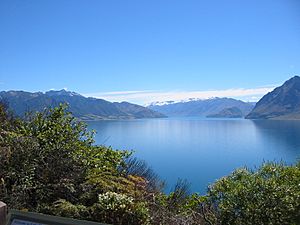Limnology facts for kids

Limnology is the study of all the fresh water on Earth that isn't part of the oceans or seas. This includes rivers, lakes, swamps, streams, wetlands, and even water found underground. It also covers bodies of water made by people, like reservoirs. Scientists who study these waters are called limnologists. Their work combines different sciences like biology (the study of living things), chemistry (the study of substances), physics (the study of energy and matter), geology (the study of Earth's structure), and hydrology (the study of water movement).
What is Limnology?
Limnology helps us understand why some lakes are full of plants and animals, while others have very few. It looks at how water bodies work, from tiny ponds to huge lakes and long rivers. Limnologists study everything from the tiny creatures and plants in the water to the rocks and soil around it. They also look at how sunlight, temperature, and chemicals affect these water environments.
Why is Limnology Important?
Studying limnology is very important for many reasons. It helps us:
- Understand how fresh water systems work.
- Protect the plants and animals that live in these waters.
- Manage water resources for drinking, farming, and industry.
- Figure out how pollution affects lakes and rivers.
- Learn about climate change and its impact on water.
For example, the Freshwater Biological Association in England did a lot of early work on lakes. They studied Windermere, a large lake, and found out why deep lakes have cold water at the bottom in summer but not in winter. They discovered that strong winds in autumn mix the warm surface water with the cold deep water. This mixing helps spread oxygen and nutrients throughout the lake.
Images for kids
-
Lake George, New York, United States, is an oligotrophic lake. This means it has very clear water and few nutrients.
See also
 In Spanish: Limnología para niños
In Spanish: Limnología para niños



